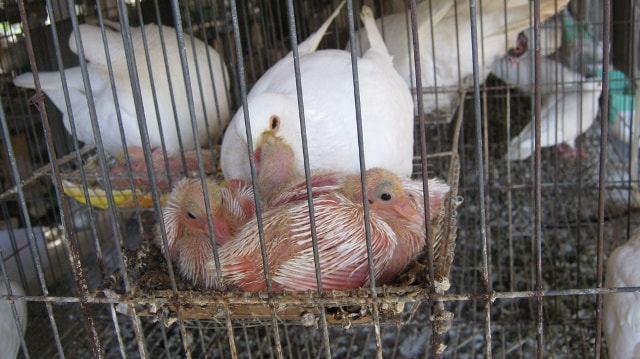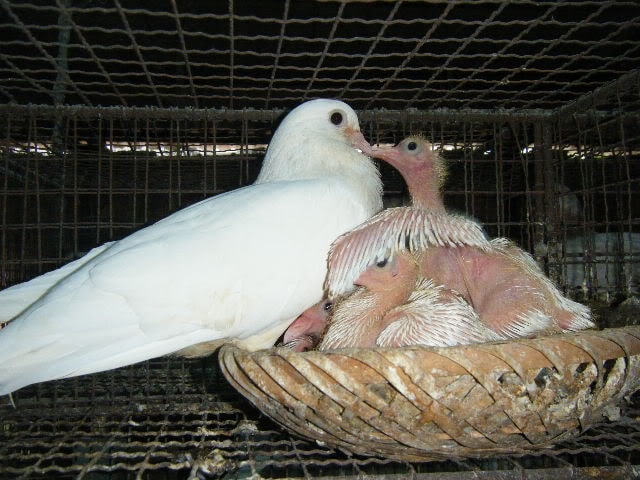Using fake eggs helps pigeons 'break plan' to lay 30 litters per year
By doing his own research, Mr. Nguyen Van Hoan in Luc Ngan district (Bac Giang) has become an 'expert' in raising pigeons. With the usual method, pigeons only lay 7-8 litters/year, but Mr. Hoan can domesticate French pigeons to lay 30 litters/year.
In 2013, giving up his pig trading job, Mr. Nguyen Van Hoan, Ha My village, Chu Dien commune, Luc Ngan district (Bac Giang) switched to raising French pigeons.
The chance to get pigeons was when Mr. Hoan brought pigs to the border gate to sell, he saw that China had to import a lot of corn and rice from Vietnam to make bird feed, but Chinese traders delivered the birds to their market workers at a much cheaper price than the same type of livestock in the country, while the transportation cost was not small. Curious, Mr. Hoan learned and also started to "practice" raising pigeons.
After more than a period of apprenticeship abroad, he returned home and boldly invested more than 400 million VND to raise 350 pairs of French pigeons using new techniques. However, “all beginnings are difficult” when the first batch of pigeons he raised all died due to environmental shock.
 |
| Pigeon farming model of Mr. Nguyen Van Hoan in Luc Ngan district, Bac Giang province. |
Not giving up, Mr. Hoan continued to go to China again, but this time to buy breeding birds. At the same time, he discovered that they were able to do so because they had breeding techniques that were many times more productive than his traditional method. By doing so, he used fake eggs to incubate the birds' eggs.
Some time later, when the first eggs hatched successfully and the baby birds were born one after another, he was extremely happy and believed that he would succeed. He chose a few pairs of parents who were good at raising their children, gave them more meals, and provided them with additional nutrition to raise the newly hatched baby birds, pairing four baby birds with one pair of parents. Thanks to separating the young early, the remaining pairs continued to reproduce very quickly afterwards.
Mr. Hoan compared: “Normally, a pair of parent birds can only raise 2 chicks and after 40-45 days they continue to lay the next litter. During that time, they consume a large amount of food, so the cost is expensive. If calculated, the economic efficiency will be low. However, separating the chicks from their mother, the birds will lay a litter after only 10-13 days, 1/4 of the time compared to the traditional way of raising. Thereby reducing input costs and increasing livestock productivity.”
 |
| Mr. Hoan uses fake eggs to incubate birds, achieving 3-4 times higher productivity than the usual method. |
The secret to Mr. Hoan increasing the pigeons' egg production is thanks to fake eggs. Fake eggs are put into the nest, real eggs are put into the incubator. "The fake eggs are put into the nest to fool the bird. Let the bird incubate for more than ten days to have crop milk to feed the chicks. When the chicks are mated, take the fake eggs out and mate them with another nest. Every 9-10 days, the mother bird can give the next batch of eggs. Meanwhile, the eggs incubated in the machine are strictly controlled in temperature so the hatching rate is up to 90%" - Mr. Hoan shared his experience.
To enable the birds to lay 27-30 clutches per year, pigeons are fed a special diet. They only eat pellets, not crushed food. Bran and spilled corn are used to feed egg-laying hens. Birds raising chicks are fed 4 times a day, while laying birds are fed 2 times a day.
“This breed of bird is large and easy to sell. After 20-22 days, the meat birds weigh about 0.6 kg each. On average, each month, I sell more than 1,000 commercial birds at 70,000 VND/bird, 300-400 pairs of breeding birds at 200,000 VND/pair to restaurants and bird farms in all the northern provinces,” said Mr. Hoan.
According to Lien Le/baodanviet
| RELATED NEWS |
|---|

